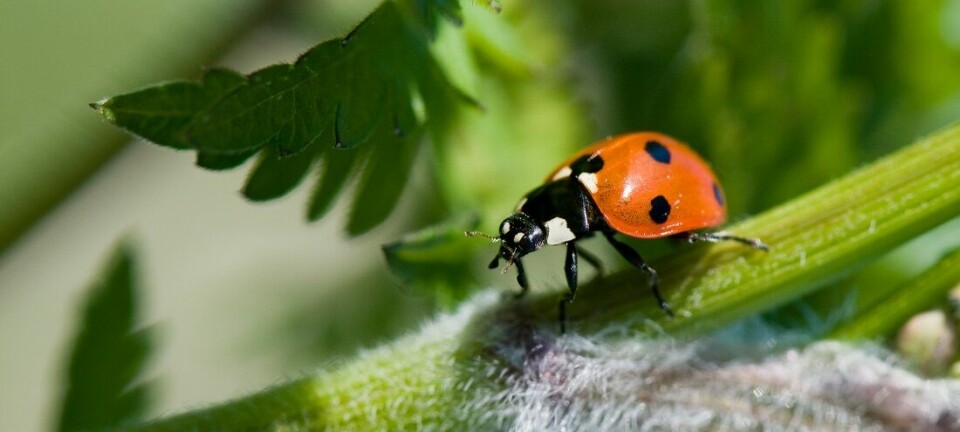
This is what a bed bug expert does every time he stays at a hotel
“I lay down and look,” says Anders Aak at the Norwegian Institute of Public Health.
“Here are 44 males,” says pest researcher Anders Aak as he holds up a small jar with crawling creatures.
These are some of the inhabitants found in the basement of the Norwegian Institute of Public Health (NIPH) in Norway’s capital Oslo.
Here, there are a series of rooms with, among other things, silverfish and bed bugs.
After the bed bug jar is taken out of its dark cabinet, the bed bugs crawl around much more than they usually do.
“They’re not fans of the light, as you can see,” the researcher says.
Feed on human blood
Bed bugs are a nightmare for many. These small, blood-sucking insects can move in with us, and they are specially adapted to a life with humans – where human blood is the only source of nutrition.
They can live behind baseboards or in your bed frame.
They come out of nooks and crannies, usually at night, to fetch food. Some people react to the bites and can develop a red rash, while others barely notice it.
“Maybe you don't notice it right away, but develop an allergy over time,” says Anders Aak.
He is an expert on insects that many of us would rather not know about. Aak works on effective methods to combat pests.

Bed bugs have been known to spill from luggage
In the dark rooms at NIPH, there are hundreds of insects in glass containers used for research. The rooms are protected with very sticky tape around the entire door frame, so none can escape and settle where they absolutely should not be.
If they somehow escape the containers, they end up in the adhesive.
Most viewed
Bed bugs can spread easily, and their population can grow quickly. Females can lay five to eight eggs a week after feeding on blood. These hatch within a few weeks, bringing forth new generations.
In the worst cases, bed bugs can easily spread further.
“There can be so many bed bugs in an apartment that they fall out of bags that have been there. But when that happens, it’s gone too far. That’s not the norm in Norway,” Aak says.
It is important to understand that these insects are not dangerous in themselves, even though many experience significant discomfort and psychological issues from having them at home, Anders Aak tells sciencenorway.no.
And he has some clear advice.
What can you do?
One of the most important measures is actually to check the places you stay, so that you do not bring any unwelcome guests home. Society could avoid many bed bug exterminations this way, Aak believes.
“My strategy is to lay down under the hotel bed to check underneath it – examining the entire bed frame closely. If I don't find any black droppings or indications of pests, I can sleep peacefully,” he says.
He has encountered bed bugs on a few occasions, including at an upscale hotel in Sweden.
“We were headed to a bed bug conference in Stockholm, and then we found bed bugs,” he says.
This highlights one of the ways bed bugs make their way into Norway – through travel.
Extremely widespread – and then completely gone
Over thousands of years, bed bugs have adapted to living alongside humans. This is one of many species that have found reproductive success by feeding on us.

The insect has been extremely widespread in the world, including in Norway and it’s capital Oslo. Bed bugs were particularly prevalent in the capital during the 1920s and 1930s, according to the Great Norwegian Encyclopedia (link in Norwegian).
As much as 30-40 per cent of all the apartments in Oslo at the time had bed bugs at some point, but this refers to the mid-20th century, according to NIPH.
Due to extermination efforts, new pesticides, and increased wealth, they almost completely disappeared over the decades leading up to the year 2000.
But then the situation changed.
An explosive growth began around the year 2000, a surge that many in large cities worldwide have noticed.
This is linked to the insects developing resistance – natural immunity – against the pesticides that had been so effective, Aak explains.
Resistant bed bugs could therefore begin to spread.
How they became resistant
The reason for the resistance is complex, but the insects have developed thicker skin which makes it harder for the pesticides to penetrate the animal.
The insects have also developed mechanisms that make the insecticide less effective, and there have been mutations that control how the insects respond to pesticides, according to this study from 2017.
There are also insecticides that have been banned indoors because of negative effects on humans in addition to the bugs.
3,000 eradication efforts a year
The increase in eradication efforts has been enormous, NIPH’s figures show. There were very few in the early 2000s. From 2010, there was a sharp increase.
“And then it reached a plateau around 3,000 eradication efforts a year,” says Anders Aak.

This situation persisted for several years, but the onset of the Covid-19 pandemic halted both travel and the spread of some bed bug infestations, resulting in the number of eradication efforts being cut in half. Activity did not pick up until people started travelling again, Aak notes.
Aak suggests that approximately half of all infestations might be attributed to travellers who inadvertedly bring these unwelcome guests home with them.
“It'll probably stabilise around 3,000 eradication efforts again,” he says.
This trend is also linked to increased public awareness of bedbugs and a growing understanding of both the issue and the methods of dealing with it among the general population.
So, what does the process of eradication look like currently?
Scorching hot critters
Since pesticides are much less effective than before, other methods are now used to get rid of bed bugs. Heating is widely used, says Anders Aak.
Combatting them in this way can be complicated and costly.
The temperature must be raised high, up to 50-55 degrees Celsius, says Anders Aak. This kills both eggs and insects, but a lot of energy is required to reach every part of a building with such high temperatures.
Hot steam can also be blown into cracks and crevices. It damages and kills the insects if they are hit directly.
Another option is the opposite: Freezing furniture or other items.
“This also requires a lot of labour. Beds, furniture, and other items must be carried, moved, transported, and stored,” Aak says.
This means that bed bug eradication can be very expensive. An average treatment costs NOK 20,000 (roughly 1,900 USD), and several treatments may be necessary to get rid of them, according to the pest control specialists at Norsk Hussopp Forsikring (link in Norwegian).
Drying out
Anders Aak is involved in developing other methods to be used by pest controllers.
One such method involves a drying powder, similar to the silica gel packets found in shoe boxes, which absorbs moisture.
This powder is effective at absorbing the moisture within bed bug bodies.
“It targets a wax layer on their skin, leading to water loss, dehydration, and eventually death,” Aak says.
Bed bugs typically perish within two to three days of exposure. The strategy involves dispersing the powder in areas where the critters move, but bed bugs are not easily fooled.
“Bed bugs can detect the dryness. They sense the discomfort of the arid conditions and think: ‘I don’t want to be here’,” he says.
Many small adjustments need to be made, and Aak says they are in the midst of working out how the powder can be used in the best possible way.
A playground for bed bugs
Among other things, they need to determine the right amount of powder so that the bed bugs won’t sense danger until it is too late.
They check this by exposing the insects to different doses and then measuring how they react to the dose. Do they avoid the powder, or do they walk over it?
One of the ways researchers are testing this is by laying out the powder on a kind of track for the bed bugs, with small platforms and pillars.

“A playground?”
“Yes, you can certainly call it that,” says Anders Aak.
There is still some work to be done before the method is ready for use, but he sees some clear patterns.
“The correct dose is crucial. We see that they avoid too high doses, but there’s little difference between a small amount of powder and no powder at all. If they walk straight through the powder, they will die from it,” Aak says.
The research will be used to develop new methods in collaboration with the pest control industry.
———
Translated by Alette Bjordal Gjellesvik
Read the Norwegian version of this article on forskning.no







































